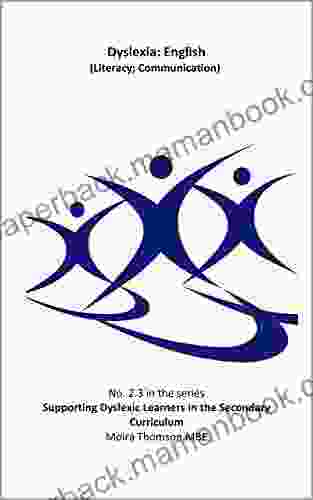Diagnostic Classroom Observation: Moving Beyond Best Practice

5 out of 5
| Language | : | English |
| File size | : | 6490 KB |
| Text-to-Speech | : | Enabled |
| Screen Reader | : | Supported |
| Enhanced typesetting | : | Enabled |
| Word Wise | : | Enabled |
| Print length | : | 200 pages |
Diagnostic classroom observation is a process of systematically observing teaching and learning in order to identify areas where students are struggling and develop targeted interventions to help them succeed.
Traditionally, classroom observation has been used primarily for summative purposes, such as evaluating teacher performance or conducting research. However, diagnostic observation can be a much more powerful tool for improving teaching and learning when it is used to inform instructional decisions.
By moving beyond best practice, you can use diagnostic observation to:
- Identify specific areas where students are struggling.
- Develop targeted interventions to help students succeed.
- Monitor student progress and make adjustments to instruction as needed.
- Evaluate the effectiveness of instructional interventions.
How to Conduct a Diagnostic Classroom Observation
The first step in conducting a diagnostic classroom observation is to define the purpose of your observation. What do you want to learn about your students? What specific areas are you concerned about?
Once you have defined your purpose, you need to choose an observation method. There are a variety of observation methods available, but some of the most common include:
- Anecdotal notes: These are brief written observations of student behavior.
- Checklists: These are lists of specific behaviors that you are looking for.
- Rating scales: These are scales that you use to rate the frequency or intensity of specific behaviors.
- Time sampling: This involves observing students for a specific period of time and recording the frequency of specific behaviors.
- Event sampling: This involves observing students until a specific event occurs.
The best observation method for you will depend on your purpose and the specific behaviors that you are interested in observing.
Once you have chosen an observation method, you need to decide how long you will observe your students. The length of your observation will depend on the purpose of your observation and the number of students that you are observing.
Finally, you need to decide how you will record your observations. You can use a variety of methods, such as writing in a notebook, using a checklist, or using a digital recording device.
Analyzing Your Observations
Once you have collected your observations, you need to analyze them to identify patterns and trends. This will help you to identify specific areas where students are struggling and develop targeted interventions to help them succeed.
There are a variety of ways to analyze your observations. Some of the most common methods include:
- Descriptive statistics: These statistics describe the frequency and distribution of your observations.
- Inferential statistics: These statistics allow you to make inferences about the population from which your sample was drawn.
- Qualitative analysis: This type of analysis involves interpreting your observations in a holistic way.
The best method of analysis for you will depend on the purpose of your observation and the type of data that you have collected.
Developing Interventions
Once you have identified specific areas where students are struggling, you need to develop targeted interventions to help them succeed.
There are a variety of different interventions that you can use, depending on the specific needs of your students. Some common interventions include:
- Providing additional instruction:
- Giving students more opportunities to practice:
- Modifying the curriculum:
- Providing social and emotional support:
The best intervention for your students will depend on their individual needs.
Monitoring Student Progress
Once you have implemented an intervention, you need to monitor student progress to ensure that it is effective.
You can monitor student progress by using a variety of methods, such as:
- Giving students quizzes or tests:
- Observing students during instruction:
- Collecting student work samples:
The best method for monitoring student progress will depend on the specific intervention that you are using.
Evaluating the Effectiveness of Interventions
Once you have monitored student progress, you need to evaluate the effectiveness of the intervention.
You can evaluate the effectiveness of an intervention by comparing student progress to a baseline measure.
If student progress has improved, then the intervention is effective.
Diagnostic classroom observation is a powerful tool for improving teaching and learning. By moving beyond best practice, you can use diagnostic observation to identify specific areas where students are struggling and develop targeted interventions to help them succeed.
5 out of 5
| Language | : | English |
| File size | : | 6490 KB |
| Text-to-Speech | : | Enabled |
| Screen Reader | : | Supported |
| Enhanced typesetting | : | Enabled |
| Word Wise | : | Enabled |
| Print length | : | 200 pages |
Do you want to contribute by writing guest posts on this blog?
Please contact us and send us a resume of previous articles that you have written.
 Top Book
Top Book Novel
Novel Fiction
Fiction Nonfiction
Nonfiction Literature
Literature Paperback
Paperback Hardcover
Hardcover E-book
E-book Audiobook
Audiobook Bestseller
Bestseller Classic
Classic Mystery
Mystery Thriller
Thriller Romance
Romance Fantasy
Fantasy Science Fiction
Science Fiction Biography
Biography Memoir
Memoir Autobiography
Autobiography Poetry
Poetry Drama
Drama Historical Fiction
Historical Fiction Self-help
Self-help Young Adult
Young Adult Childrens Books
Childrens Books Graphic Novel
Graphic Novel Anthology
Anthology Series
Series Encyclopedia
Encyclopedia Reference
Reference Guidebook
Guidebook Textbook
Textbook Workbook
Workbook Journal
Journal Diary
Diary Manuscript
Manuscript Folio
Folio Pulp Fiction
Pulp Fiction Short Stories
Short Stories Fairy Tales
Fairy Tales Fables
Fables Mythology
Mythology Philosophy
Philosophy Religion
Religion Spirituality
Spirituality Essays
Essays Critique
Critique Commentary
Commentary Glossary
Glossary Bibliography
Bibliography Index
Index Table of Contents
Table of Contents Preface
Preface Introduction
Introduction Foreword
Foreword Afterword
Afterword Appendices
Appendices Annotations
Annotations Footnotes
Footnotes Epilogue
Epilogue Prologue
Prologue Tony Horwitz
Tony Horwitz Christine A Courtois
Christine A Courtois Bob Hartman
Bob Hartman Jeorald Pitts
Jeorald Pitts Ger Arevalo
Ger Arevalo Gabriel Martz
Gabriel Martz Max Dubois
Max Dubois Georg F L Bausch
Georg F L Bausch Robert B Gordon
Robert B Gordon Paramahansa Yogananda
Paramahansa Yogananda Sheri Fink
Sheri Fink Rachel Hoffman
Rachel Hoffman E Pauline Johnson
E Pauline Johnson Robert Greene
Robert Greene Ellis Morgan
Ellis Morgan Foxy Feather
Foxy Feather W H Thomas
W H Thomas Lee Conrad
Lee Conrad Roger Marshall
Roger Marshall Kim Solga
Kim Solga
Light bulbAdvertise smarter! Our strategic ad space ensures maximum exposure. Reserve your spot today!

 Curtis StewartUnveiling the Enigmatic Michael Robins: A Comprehensive Examination of the...
Curtis StewartUnveiling the Enigmatic Michael Robins: A Comprehensive Examination of the...
 Billy Foster10 Survival Tips for Nurses to Get Through the Night as a Licensed Practical...
Billy Foster10 Survival Tips for Nurses to Get Through the Night as a Licensed Practical... Jackson HayesFollow ·14.8k
Jackson HayesFollow ·14.8k Adrian WardFollow ·12.3k
Adrian WardFollow ·12.3k Bob CooperFollow ·7.6k
Bob CooperFollow ·7.6k Chance FosterFollow ·11.4k
Chance FosterFollow ·11.4k Everett BellFollow ·14k
Everett BellFollow ·14k Vince HayesFollow ·17.2k
Vince HayesFollow ·17.2k Emmett MitchellFollow ·11.9k
Emmett MitchellFollow ·11.9k Samuel WardFollow ·7.6k
Samuel WardFollow ·7.6k

 Jeremy Mitchell
Jeremy MitchellPlay We Now On Christmas Violin Christmas: A Heartfelt...
Play We Now On...

 Terry Bell
Terry BellTales from the Road: Confessions of an Atlanta Uber...
In the vibrant...

 Ervin Bell
Ervin BellThe French Admiral: A Gripping Naval Adventure with Alan...
In the vast expanse of...

 Henry David Thoreau
Henry David ThoreauCrochet Cozy Afghan Patterns: Crochet Weekend Afghan...
to Crochet...

 Orson Scott Card
Orson Scott CardAn Archaeological View Of The Industrialization Of North...
The industrialization of North America was a...

 Josh Carter
Josh CarterClipboard Christmas Skits by Tom Spence: A Festive...
A Christmas...
5 out of 5
| Language | : | English |
| File size | : | 6490 KB |
| Text-to-Speech | : | Enabled |
| Screen Reader | : | Supported |
| Enhanced typesetting | : | Enabled |
| Word Wise | : | Enabled |
| Print length | : | 200 pages |







